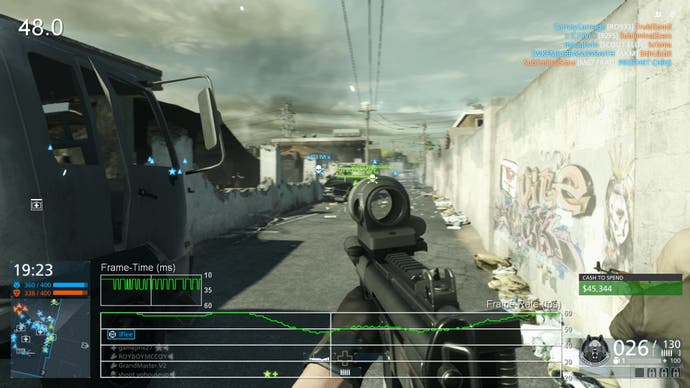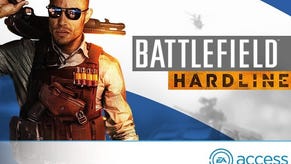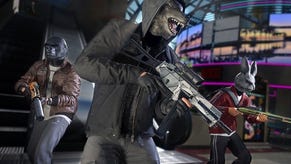Performance Analysis: Battlefield Hardline Multiplayer
Visceral aims for 60fps gameplay on PS4 and Xbox One - but high player counts can impact performance.
With much to prove after Battlefield 4's stability woes at launch, the delayed Hardline takes no chances in getting it right. Having tracked the game's progress since its early E3 2014 reveal, the recent beta showed a clear advance in overall performance levels, promising a more polished end product on day one. Today, we have the final PlayStation 4 and Xbox One code to hand, where to varying degrees we see Visceral Games' efforts paying off - though it's clear a locked 60fps is still a hard won fixture on console.
As before, frame-rate in console Battlefield is at the mercy of three factors: player count, transparency effects, and the use of Frostbite 3's physics engine. Given the full breadth of nine multiplayer maps, we can now move past the beta's familiar areas (Downtown, Dust Bowl and Bank Job) to see how the balance of the maps fare. A direct comparison between PS4 and Xbox One is not possible given the variables at play here, but as a broad indication the results show an intriguing trend.
Cranking the player count up to 64, some maps hold up in performance terms more adeptly than others. As ever, triggered events like the collapsing of the Hollywood Heights' central building cause big momentary drops - similar to the crashing crane on the Downtown stage. However, it's compact maps such as The Block that strain PS4 and Xbox One more consistently, where sustained periods at between 40-50fps are possible when a match is in full flow.
Built with chaotic Team Deathmatch fracases in mind, The Block is fairly unique within Hardline's suite of maps. A long, narrow stretch packed in tight with physics-affected buildings, each individual structure is gradually chip-damaged over the course of a shoot-out, and most houses can be leveled entirely. When crammed with 64 players, the focus on physics-based destruction causes very erratic lurches on our graph, quite unlike any other stage. At its nadir, both PS4 and Xbox One fall closer to 40fps to produce very sluggish controller response - easily the worst we see in the game after days of testing.
Given the choppier graph read-out, a CPU bottleneck is the likely culprit given the heavy physics element of the stage - though it's also apparent Xbox One suffers more greatly when computationally expensive alpha effects are in play. Thankfully this low level of performance takes a fully populated game to achieve, whereas smaller games with 32 players flag no major issues. For example, from a 8,100 frame sample of major stress points on The Block, we see 741 (9.15%) frames dropped when maxed out at 64 players. Conversely, even factoring the absolute worst clips from a 32-player game, only 41 frames are dropped (0.50%) from the same sized test sample.
It makes a noticeable difference in practice. This is also the case for the Hollywood Heights stage; sparing a few blips southward, this medium-sized map holds at a smooth 60fps until each team fills out the ranks. However, it never quite reaches the same lows as The Block.
Other maps, such as the storm-battered Riptide and sparse marshlands of the Everglades fare much better. Even with 64 players in action with SUVs and helicopters whipping past, the regularity of drops is much lower overall. In fact, the broader, sparser spread of these maps helps to prevent too many players cluttering up into one space, making it rare to see PS4 or Xbox One dipping below 50fps. More barren levels like Derailed hold up well at 60fps too, even during long over-views of the landscape when manning an airborne turret.
So far, neither console shows a conclusive advantage over the other in frame-rate (exact like-for-like comparisons of render tech will have to wait for the single-player analysis). Indeed, the biggest difference is still in the resolution stakes; Xbox One runs at a 1280x720 internal resolution, and the PS4 sticks to 1600x900. Each delivers these massive sandbox maps at the same visual presets too; pop-in occurs at the same distance, while effects and textures are matched for quality. Sadly the low-grade screen-space ambient occlusion (SSAO) and pixel-crawl artefacts carry straight over from Battlefield 4 too - two points we had hoped would be addressed for Hardline.
But what of the game's overall stability in multiplayer? Given the spate of issues that plagued Battlefield 4, eyes are on this release to nail it out of the box. Having tested the PS4 version's multiplayer at an EA-hosted event, it bears mention that we saw around five crashes over the course of the first day. These manifested as server hang-ups that forced all attendees to restart a match. It's an unfortunate initial impression given Visceral Games' efforts to optimise, though to be fair we experienced no crashes on the second day.

| Team Deathmatch/The Block Stress Test | Xbox One (32 Players) | Xbox One (64 Players) |
|---|---|---|
| Lowest Frame-Rate | 47.0fps | 44.0fps |
| Dropped Frames (from 8106 total) | 41 (0.50%) | 741 (9.15%) |
Nearby staff explain this bug is unique to the setup of the event. We're told the multiplayer build in use on each debug machine is stripped of the single-player component, reducing the overall game size from around 41GB to 17.6GB. It's explained that the knock-on-effect here is that the game searches for absent 'dependencies' - certain files in the game's database that were cut for this press event - at which point the match is forced to refresh for all players.
Despite taking the final retail code back to our offices (with single-player portion intact), testing this for ourselves on PS4 is impossible right now due to the inactive servers. The final verdict on this will have to wait, though the state of Xbox One multiplayer is looking positive so far. Courtesy of EA's Early Access scheme, we had no shortage of opponents to play against using our final retail disc version, and a whole day of intensive testing flagged up a single soft lock. As ratios go this is more promising, but it remains to be seen how both PS4 and Xbox One versions will hold up against the rush of day one buyers.
A full analysis of Battlefield Hardline's single-player will also be telling - an area we'll delve into soon with like-for-like tests between PS4 and Xbox One. However, using the multiplayer as an example of Frostbite 3 progress on current-gen, it's disappointing to see an extra year of development failing to show any real technical leap over Battlefield 4. Even so, Visceral's new map rotation doesn't disappoint; it may be sub-60fps with 64 players, but the commitment to map scale and physics-based destruction still takes its moment to impress.











